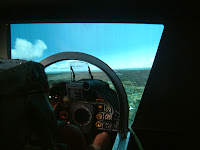When I got the opportunity to try the AJSH37 simulator at F7 airbase in Såtenäs, I never got to see the radar display in action. The reason for this, they said, was that it was still classified. I thought that was a little strange since this is an obsolete aircraft that was about to be scrapped and there isn't really anything from this system that is used in the new JAS39, except perhaps for shooting boundaries displayed in some weapon modes. When I tried the AJSH37 simulator at SAAB they also thought it was a bit strange but unfortunately their simulator did not have any simulation of the radar image. I got to see the symbology though. And we've been able to get a few glimpses of the radar image through different showcase movies from the air force, and there are a few scenes showing the radar in the film "Älskar älskar inte".
However, at F7 though I never got to see the radar display itself, I got to see the unit that produced the radar image. It was a locker as large as a couple of fridges. The whole simulator was housed in a room as large as tennis court. Inside the locker there were two large vertically placed silver coated glass plates with the topography of Sweden (and some areas around) etched into i. Basically you could say it was a silvery 3D map of the area of operation. The reason there were two plates is that Sweden is a very long country, and it was easier to handle this way. Just above the surface of this 3D map there was a moving unit with a light source, representing the radar of the aircraft, and a camera picking up the light from a "God's perspective". It might sound a bit strange, but it's actually really genius, considering this sim was built in the early 70's. If you think about it, it is almost the way a radar really works.

Take a flashlight and lay it on an uneven surface, like a gravel road, lightening along the surface. Then view the surface from above. You will notice that all bumps will produce small shadows behind them, all in the direction away from the light source. The parts of the surface receiving light are all visible from the the light source, the other parts are dark. So what you see from above is exactly the same as from the flashlight, only from a different perspective. The radar receiver in an airplane is located in the same place as the sender, "light source", not a few miles ahead and above the airplane. However radar also gives you depth information so it's a piece of cake to translate it into a "God's view".
This is a somewhat simplistic view of how a radar works, not considering refraction, jitter effect, polarization etc. But for the purpose of a Viggen simulator it's good enough. After my visit to F7 I started thinking about the possibility to make a similar radar simulation with 3D hardware, using OpenGL. I will discuss this in part 2.









